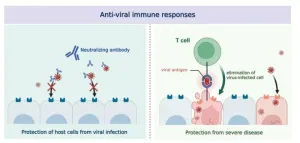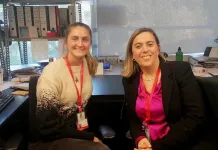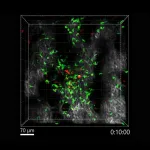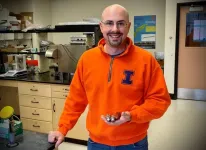(Press-News.org) When Ben Brown, research assistant professor of chemistry, thinks about the opioid epidemic, he views the problem on a molecular level. Painkillers used legitimately in medicine, such as oxycodone, are highly addictive, but better understanding of how their molecules interact with proteins in the body could lead to the formulation of nonaddictive alternatives, he said.
In May, the National Institute on Drug Abuse awarded Brown $1.5 million over five years to further his work in this area. Brown, faculty affiliate of the Vanderbilt Center for Addiction Research and the Center for Applied Artificial Intelligence in Protein Dynamics, is developing artificial intelligence that analyze billions of potential opioid drugs to reveal detailed insights into how they interact with key proteins. The remaining $875,000 of the grant will flow to Vanderbilt for indirect and administrative costs connected to Brown’s research.
Brown will focus his research on Mu-opioid receptors, signaling proteins in the central nervous system that bind with opioids. These receptors modulate pain, stress, mood and other functions. Drugs that target these receptors are among the most powerful analgesics, but they also are the most addictive.
The grant, an Avenir Award in Chemistry and Pharmacology of Substance Use Disorders, is awarded by NIDA to early-stage investigators who propose highly innovative studies and represent the future of addiction science.
“The energy and enthusiasm Ben brings to his science and scientific collaborations are outstanding, and it is fitting that he be recognized as a young pioneer in his field,” said Hassane Mchaourab, director of the Center for Applied AI in Protein Dynamics and Louise B. McGavock Chair and professor of molecular physiology and biophysics. “Ben is one of the intellectual contributors behind the founding of the Center for Applied AI in Protein Dynamics. I anticipate that Ben will make fundamental advances in multiple core aspects of computer-aided drug design,” he said.
Brown’s computational platform models drug-protein interactions in a way that accounts for their dynamic physical movements. These movements, called conformational changes, can occur in milliseconds and make a big difference in how a protein behaves and binds or interacts with a small molecule drug.
By computationally modeling this motion, algorithms can more effectively predict how tightly proteins and drugs will interact and the effects of this interplay. This information is used to screen billions of potential drugs—an unprecedented scale for highly dynamic proteins—or design new ones with properties that lead to fewer addictive side effects.
Computational platforms that model the structure of proteins and how they interact with drugs already exist, but they largely neglect conformational changes and poorly predict how a new drug will behave. That’s due in part to the paucity of data available for training algorithms.
With data-rich material from researchers Craig Lindsley, Heidi Hamm and Vsevolod V. Gurevich from Vanderbilt, Matthias Elgeti of Leipzig University and Wu Beili of Shanghai Institute of Materia Medica, Brown will synthesize, functionally validate and structurally characterize drug molecules and receptors designed by the researchers. Following this component of the grant, Brown will feed the data back into the computational platform so it can be used as a starting point for more rounds of optimization—a computational-experimental iterative feedback loop.
“You see pediatric patients have a surgery, and they’re on an opioid postoperatively, and then they’ve got a problem after that. It’s really sad,” Brown said. “So the goal is to provide analgesia without risking addiction. And for those who have addiction, to provide new medications to help with recovery.”
In addition to the Center for Applied AI in Protein Dynamics and VCAR, Brown’s research affiliations include the Center for Structural Biology and the Vanderbilt Institute of Chemical Biology.
END
Vanderbilt chemist Ben Brown awarded $2.375M to develop nonaddictive painkillers with AI
2024-01-19
ELSE PRESS RELEASES FROM THIS DATE:
National champion tree program finds new home
2024-01-19
The National Champion Tree Program started 83 years ago at American Forests to discover the largest, living trees in the United States. Now, the program is moving from the organization’s headquarters to a new home in the School of Natural Resources at the University of Tennessee Institute of Agriculture (UTIA).
American Forests launched the Champion Tree Program in 1940. Its vision included establishing a nationwide laboratory for the study of forestry and trees. Being housed at Tennessee’s 1862 public land-grant university will advance the program’s understanding of big trees. “The National Champion Tree Program moving to UTIA means it can continue protecting ...
New AEM study evaluates potential disparities in restraint use in the emergency department at a minority-serving safety-net hospital
2024-01-19
Des Plaines, IL — A new study that contributes additional data to a growing body of evidence demonstrating disparities in restraint use in the emergency department (ED) has been published in the January issue of Academic Emergency Medicine (AEM), the peer-reviewed journal of the Society for Academic Emergency Medicine (SAEM). The study, titled Disparities in use of physical restraints at an urban, minority-serving hospital emergency department evaluates the association between race/ethnicity and the use of restraints in an ED population ...
CRISPR off-switches: A path towards safer genome engineering?
2024-01-19
Using CRISPR, an immune system bacteria use to protect themselves from viruses, scientists have harnessed the power to edit genetic information within cells. In fact, the first CRISPR-based therapeutic was recently approved by the FDA to treat sickle cell disease in December 2023. That therapy is based on a highly studied system known as the CRISPR-Cas9 genetic scissor.
However, a newer and unique platform with the potential to make large-sized DNA removals, called Type I CRISPR or CRISPR-Cas3, waits in the wings for potential therapeutic use.
A new study from Yan Zhang, ...
Evolution of the human immune system in the post-Omicron era
2024-01-19
It has been 4 years since the start of the COVID-19 pandemic. SARS-CoV-2 has yet to be eradicated and new variants are continuously emerging. Despite the extensive immunization programs, breakthrough infections (infection after vaccination) by new variants are common. New research suggests that human immune responses are also changing in order to combat the never-ending emergence of new SARS-CoV-2 variants. Specifically, it has been discovered the immune system that encountered breakthrough infection by the Omicron variant acquires enhanced immunity against future versions of the Omicron.
A team of South Korean scientists ...
First therapeutic target for preserving heart function in patients with pulmonary hypertension
2024-01-19
A team led by Dr. Guadalupe Sabio at the Centro Nacional de Investigaciones Cardiovasculares (CNIC) in Madrid has discovered a possible therapeutic target for pulmonary hypertension.
The study, published in the journal Science Advances, identifies the first therapeutic target that can be modulated to preserve cardiac function in pulmonary hypertension, providing hope in the fight against this rare but fatal disease for which there is currently no cure.
Pulmonary hypertension is a condition of elevated blood pressure in the arteries that carry deoxygenated blood to the lungs. This increased pulmonary blood pressure puts the heart under continuous strain ...
Endless biotechnological innovation requires a creative approach
2024-01-19
Scientists working on biological design should focus on the idiosyncrasies of biological systems over optimisation, according to new research.
In a study, published today in Science Advances, researchers from the Universities of Bristol and Ghent have shown how exploring the unknown may be the crucial step needed to realise the continual innovation needed for the biotechnologies of the future.
Recognising the role of open-endedness in achieving this goal and its growing importance in fields like computer science and evolutionary biology, the team mapped out how open-endedness is linked to bioengineering practice today and what would be required to achieve it in ...
The secret life of CD4+ T cells: from helpers to melanoma fighters
2024-01-19
In the study led by the Peter Doherty Institute for Infection and Immunity (Doherty Institute) and published in Science Immunology, the researchers found that CD4+ T cells, traditionally called ‘helper T cells’ for their role in aiding the activation of other immune cells, are remarkably effective in controlling melanoma.
University of Melbourne’s Dr Emma Bawden, Postdoctoral Researcher at the Doherty Institute and lead author of the study, said this discovery challenges the conventional understanding of the role of CD4+ T cells in cancer immunity.
“Our ...
Study says ice age could help predict oceans’ response to global warming
2024-01-19
A team of scientists led by a Tulane University oceanographer has found that deposits deep under the ocean floor reveal a way to measure the ocean oxygen level and its connections with carbon dioxide in the Earth's atmosphere during the last ice age, which ended more than 11,000 years ago.
The findings, published in Science Advances, help explain the role oceans played in past glacial melting cycles and could improve predictions of how ocean carbon cycles will respond to global warming.
Oceans adjust atmospheric CO2 as ice ages transition to warmer climates by releasing the greenhouse ...
From snack to science: Innovative grant brings popcorn into the classroom
2024-01-19
URBANA, Ill. — In a few years, popcorn could become a standard element in science classrooms across Illinois and the nation. With funding from a new USDA grant, a University of Illinois Urbana-Champaign crop scientist and collaborating educators are developing a popcorn-based curriculum to reinforce concepts around agricultural science, artificial intelligence, biotechnology, computer science, genomics, research methods, and more for 4-H and high school students.
The funding may be new, but Tony Studer has proselytized ...
The case of a patient with multiple myeloma cured after hepatitis treatment reveals that this cancer can be caused by viruses, and opens up new treatment options
2024-01-19
Hepatitis C and B viruses are one of the causes of this type of cancer –a most frequent on in blood–, and the pathologies that precede it, known as gammopathies.
Early identification of an infection with these viruses can help doctors to prescribe appropriate treatment and prevent it from leading to malignant pathologies.
The research has been discussed in an editorial article in the journal Haematologica
A few years ago, a patient was cured of multiple myeloma after being treated for hepatitis C, astounding researchers from the group led by Joaquín ...







